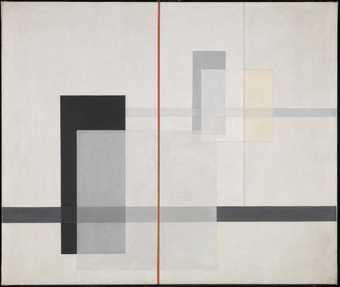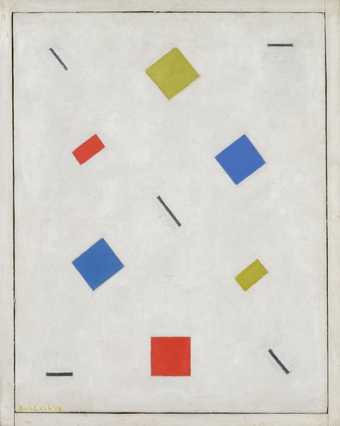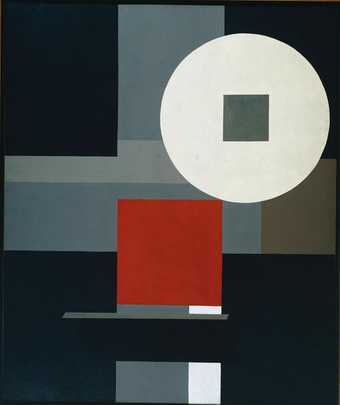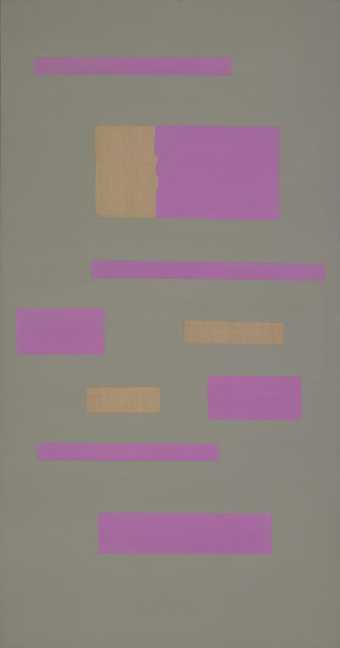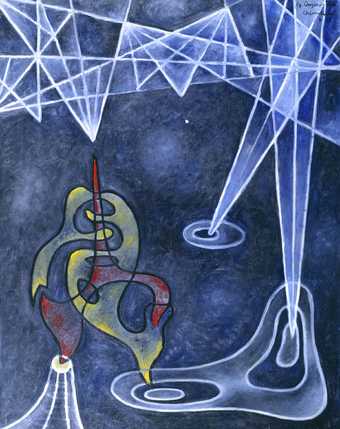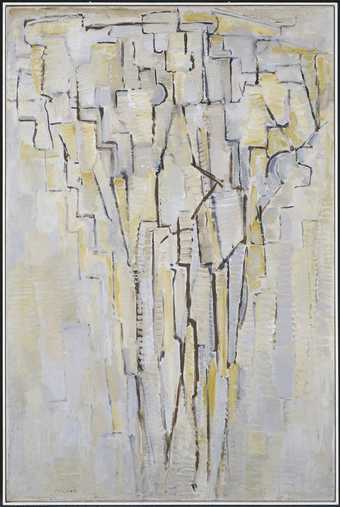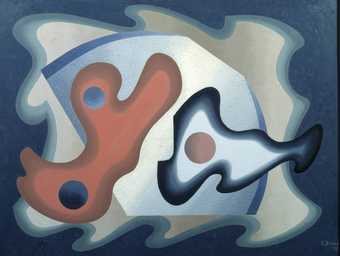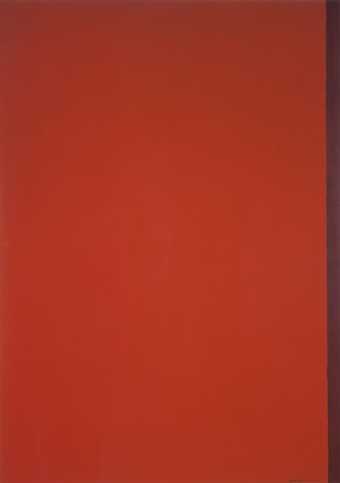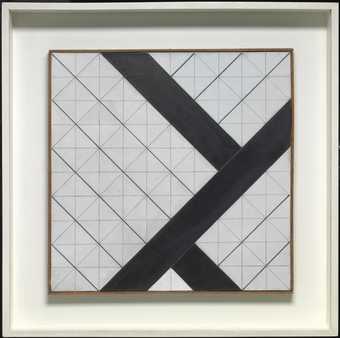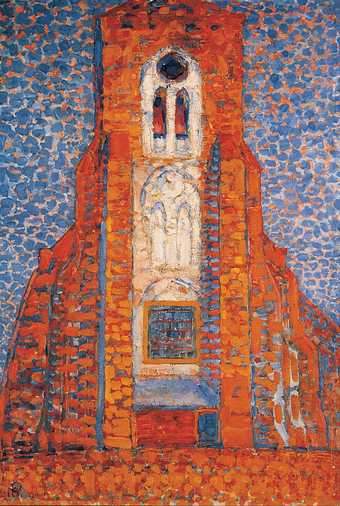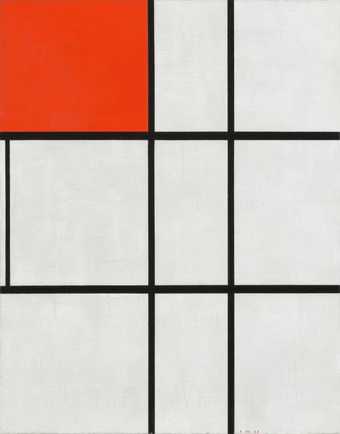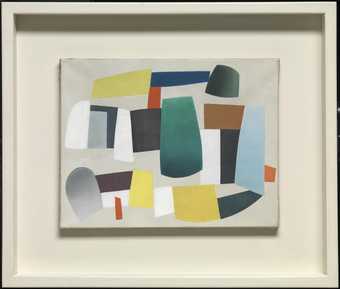
Not on display
- Artist
- Piet Mondrian 1872–1944
- Medium
- Oil paint on canvas
- Dimensions
- Support: 997 × 1003 mm
frame: 1163 × 1163 × 62 mm - Collection
- Tate
- Acquisition
- Purchased 1967
- Reference
- T00915
Display caption
An early example of Mondrian's pure geometric abstraction, this painting dates from his involvement with the De Stijl group. The strict use of horizontal and vertical lines and primary colours with black and grey is characteristic of De Stijl. Mondrian's aim to evoke a spiritual equilibrium was influenced by the mysticism of Theosophy, which sought universal order. He had been working with chequerboard grids before he began this painting, which introduced greater variety. He told van Doesburg: 'now I do not always keep to the proportional division'.
Gallery label, August 2004
Does this text contain inaccurate information or language that you feel we should improve or change? We would like to hear from you.
Catalogue entry
Piet Mondrian 1872-1944
T00915 Composition in Grey, Red, Yellow and Blue
c.1920-7
Inscribed 'PM 20' b.r. and 'P. MONDRIAN | Composition N: II' on stretcher
Oil on canvas, 394 x 394 (100.5 x 101)
Purchased from the Marlborough-Gerson Gallery, New York, through Marlborough Fine Art, London (Special Grant-in-Aid) 1967
Prov:
Harry Holtzman, New York (bequest from the artist); with Marlborough-Gerson Gallery, New York
Exh:
Architectuur, Schilderkunst & Beeldhouwkunst, Stedelijk Museum, Amsterdam, February-March 1928 (93) as 'Composition' 1920; Piet Mondrian, Museum of Modern Art, New York, March-May 1945 (21 on checklist); Piet Mondrian 1910-1944, Sidney Janis Gallery, New York, October-November 1949 (18); 50 Years of Mondrian, Sidney Janis Gallery, New York, November 1953 (25); Mondrian, Sidney Janis Gallery, New York, September-November 1957 (13, repr.); Mondrian, de Stijl and their Impact, Marlborough-Gerson Gallery, New York, April 1964 (20, repr. in colour); Piet Mondrian 1872-1944, Santa Barbara Museum of Art, January-February 1965 (53, repr. in colour); Dallas Museum of Fine Arts, March-April 1965 (53, repr. in colour); Fifty Years of Modern Art 1916-1966, Cleveland Museum of Art, June-July 1966 (19, repr. in colour); Piet Mondrian, Nationalgalerie, Berlin, September-November 1968 (43); Mondrian, Orangerie des Tuileries, Paris, January-March 1969 (63); Piet Mondrian 1872-1944, Guggenheim Museum, New York, October-December 1971 (85, repr.); Kunstmuseum, Bern, February-April 1972 (81, repr.)
Lit:
Michel Seuphor, Piet Mondrian: Life and Work
(London 1956), No.449, p.426, repr. p.383 (c.c.303); Michel Seuphor, Piet Mondrian: sa Vie, son Oeuvre
(Paris 1970), No.472, p.424, repr. p.383, pl.303; Maria Grazia Ottolenghi, L'Opera Completa di Mondrian
(Milan 1974), No.316, p.109, repr. p.108
Repr:
Art News, LXIII, May 1964, p.41 in colour
This picture has sometimes been exhibited since Mondrian's death as 'Composition 2' or 'Composition N:II' because of the inscription 'Composition N:II' on the stretcher, but it was Mondrian's usual practice to add inscriptions of this type when he sent works to exhibitions, numbering his abstract compositions in order. The stretcher also bears an obliterated inscription 'N VI', and a Robinot Frères label which shows that the picture was transported from Paris to Amsterdam for an unspecified exhibition. It seems very probable that this was the exhibition Architectuur, Schilderkunst & Beeldhouwkunst
at the Stedelijk Museum, Amsterdam, in 1928, in which the sixth Mondrian 'Composition' out of a group of eight was 'Compositie' 1920, priced F 300. J.M. Joosten, who is preparing a catalogue raisonné of Mondrian's work, says that he has no record of any other exhibition with so many numbers in which it could be fitted. If it was exhibited in 1928, and the number VI refers to that, then it must have been exhibited once more later on in Mondrian's lifetime as the second of his exhibits, though this exhibition has not yet been identified.
It is one of the largest of a stylistically related group of seven paintings dated from 1919 to early 1921 (Seuphor c.c.302-6 and 313) in which he used larger rectangles than before and with black, several different tones of grey, and the three primary colours mixed with grey. Two photographs taken of his studio at 26 Rue du Départ, Paris, apparently on the same day some time in the mid 1920s, show this particular picture hanging on the wall above a doorway and seem to prove that he must have subsequently repainted parts of the composition. For example, all the rectangles which are now yellow appear in the photographs to be very dark in tone. (The yellows were clearly applied over darker colours). Though there seems to be no record of exactly when these photographs were taken, J.M. Joosten points out that one appears to have been first reproduced in the Dutch newspaper De Telegraaf
on 12 June 1926 and the other in Der Querschnitt, VIII, February 1928. The probability is that the painting, though signed and dated 1920, was reworked and finished between about 1926 and the date of its first exhibition in 1928.
Published in:
Ronald Alley, Catalogue of the Tate Gallery's Collection of Modern Art other than Works by British Artists, Tate Gallery and Sotheby Parke-Bernet, London 1981, pp.533-5, reproduced p.533
Explore
- abstraction(8,615)
-
- non-representational(6,161)
- formal qualities(12,454)
You might like
-
László Moholy-Nagy K VII
1922 -
Piet Mondrian Composition with Yellow, Blue and Red
1937–42 -
Bart van der Leck Composition
1918 -
Friedrich Vordemberge-Gildewart Composition No. 15
1925 -
Ad Reinhardt Abstract Painting
c.1951–2 -
Gordon Onslow-Ford Determination of Gender
1939 -
Piet Mondrian The Tree A
c.1913 -
John Bigge (Sir John Amherst Selby-Bigge, Bt) Composition
1933 -
Barnett Newman Eve
1950 -
Theo van Doesburg Counter-Composition VI
1925 -
Barnett Newman Moment
1946 -
Piet Mondrian Sun, Church in Zeeland; Zoutelande Church Facade
1909–10 -
Piet Mondrian Composition B (No.II) with Red
1935 -
Jean Hélion Abstract Composition
1934 -
Judith Rothschild Untitled Composition
1945

